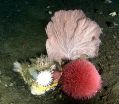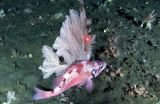Bering Sea hotspot for corals and sponges
Research biologist Robert Miller partnered with Greenpeace to demonstrate that Pribilof Canyon protections would not heavily impact fishing industry
2015-07-30
(Press-News.org) North of the Aleutian Islands, submarine canyons in the cold waters of the eastern Bering Sea contain a highly productive "green belt" that is home to deep-water corals as well as a plethora of fish and marine mammals.
Situated along the continental slope, the area also supports a thriving -- but potentially environmentally damaging -- bottom-trawling fishing industry that uses large weighted nets dragged across the seafloor to scoop up everything in their path.
A new study, conducted by research biologist Robert Miller of UC Santa Barbara's Marine Science Institute and colleagues from Greenpeace, combines a variety of data to identify coral and sponge habitats that may be threatened by bottom-trawling. Further, the investigators also used the results of their habitat models to evaluate how restrictions on bottom-contact fishing in Bering Sea canyons could impact the fishing industry. The results appear in the journal Global Ecology and Conservation.
"There's a growing awareness of deep-water corals and their importance as fish habitat as well as their vulnerability to bottom trawling," said lead author Miller. "They take a long time -- tens to hundreds of years -- to recover from being destroyed by bottom trawlers, particularly the big specimens, which can be really old."
The research model incorporated data from bycatch records, National Oceanic and Atmospheric Administration (NOAA) surveys and Greenpeace-led submersible expeditions as well as physical oceanographic data such as temperature, bottom slope and current speed to identify the best locations for coral and sponge habitat in the Bering Sea. They found that Pribilof Canyon -- an area larger than the Grand Canyon -- contains the area's densest populations of deep-sea corals and sponges.
One of five major canyons carved into the Bering Sea slope, Pribilof contains more than 50 percent of the estimated high-quality deep-sea coral habitat and 45 percent of sponge habitat, despite making up less than 2 percent of the entire area covered by the study. The amount of quality coral and sponges varied in the other canyons, but overall they contained more than other parts of the continental slope.
"In this study, we found Pribilof Canyon to be a hotspot for coral habitat in the Bering Sea," Miller said. "In a previous study, we showed that these corals seem to be important fish habitat. So if conserving essential fish habitat and corals is important to ocean managers, Pribilof Canyon would be a good area on which to focus their efforts. Equally important, our analysis also demonstrates that Pribilof Canyon could be conserved without disproportionately impacting the commercial fishing industry."
INFORMATION:
ELSE PRESS RELEASES FROM THIS DATE:
2015-07-30
CAMBRIDGE, Mass--Two key physical phenomena take place at the surfaces of materials: catalysis and wetting. A catalyst enhances the rate of chemical reactions; wetting refers to how liquids spread across a surface.
Now researchers at MIT and other institutions have found that these two processes, which had been considered unrelated, are in fact closely linked. The discovery could make it easier to find new catalysts for particular applications, among other potential benefits.
"What's really exciting is that we've been able to connect atomic-level interactions of water ...
2015-07-30
A team of scientists has linked changes in the structure of a handful of central brain neurons to understanding how animals adjust to changing seasons. Its findings enhance our understanding of the mechanisms vital to the regulation of our circadian system, or internal clock.
The work, which appears in the journal Cell, focuses on the regulation of "neuronal plasticity"--changes in neuronal structure--and its function in the brain.
"Neuronal plasticity underpins learning and memory, but it is very challenging to tie changes in specific neurons to alterations in animal ...
2015-07-30
Despite their remarkably similar appearance, the "golden jackals" of East Africa and Eurasia are actually two entirely different species. The discovery, based on DNA evidence and reported in the Cell Press journal Current Biology on July 30, increases the overall biodiversity of the Canidae--the group including dogs, wolves, foxes, and jackals--from 35 living species to 36.
"This represents the first discovery of a 'new' canid species in Africa in over 150 years," says Klaus-Peter Koepfli of the Smithsonian Conservation Biology Institute in Washington, DC.
The new study, ...
2015-07-30
The desire to quit smoking--often considered a requirement for enrolling in treatment programs--is not always necessary to reduce cigarette cravings, argues a review of addiction research published July 30 in Trends in Cognitive Sciences. Early evidence suggests that exercises aimed at increasing self-control, such as mindfulness meditation, can decrease the unconscious influences that motivate a person to smoke.
Scientists are looking to the brain to understand why setting a "quit day" isn't a surefire way to rid oneself of a cigarette habit. Recent neuroimaging studies ...
2015-07-30
A study that took a novel approach to investigating factors affecting the emergence of symptoms of Huntington's disease (HD) has identified at least two genome sites that house variants that can hasten or delay symptom onset. In their report in the July 30 issue of Cell, the multi-institutional research team describes how genome-wide association analysis of samples from more than 4,000 HD patients found that particular variants on two chromosomes were more common in individuals who first exhibited HD-associated movement disorders either earlier or later than would otherwise ...
2015-07-30
Not every mom and dad agree on how their offspring should behave. But in genetics as in life, parenting is about knowing when your voice needs to be heard, and the best ways of doing so. Typically, compromise reigns, and one copy of each gene is inherited from each parent so that the two contribute equally to the traits who make us who we are. Occasionally, a mechanism called genomic imprinting, first described 30 years ago, allows just one parent to be heard by completely silencing the other.
Now, researchers at the University of Utah School of Medicine report on a ...
2015-07-30
A new imaging tool developed by Boston scientists could do for the brain what the telescope did for space exploration. In the first demonstration of how the technology works, published July 30 in the journal Cell, the researchers look inside the brain of an adult mouse at a scale previously unachievable, generating images at a nanoscale resolution. The inventors' long-term goal is to make the resource available to the scientific community in the form of a national brain observatory.
"I'm a strong believer in bottom up-science, which is a way of saying that I would prefer ...
2015-07-30
Oropharyngeal cancer patients who were found to have detectable traces of human papillomavirus type 16 (HPV16) in their saliva following cancer treatment are at an increased risk for recurrence, a study led by researchers at the Johns Hopkins Bloomberg School of Public Health has found.
The oropharynx is the area of the upper throat that includes the back of the tongue, the soft palate, the tonsils and the walls of the throat. Oropharyngeal cancer accounts for 2.8 percent of new cancers in the United States; it is often treated successfully with surgery.
In a small ...
2015-07-30
In the last two decades, prosthetic limb technology has grown by leaps and bounds. Today, the most advanced prostheses incorporate microprocessors that work with onboard gyroscopes, accelerometers, and hydraulics to enable a person to walk with a normal gait. Such top-of-the-line prosthetics can cost more than $50,000.
Amos Winter is aiming to develop a passive, low-tech prosthetic knee that performs nearly as well as high-end prosthetics, at a fraction of the cost.
"We're going after this disruptive opportunity," says Winter, an assistant professor of mechanical ...
2015-07-30
NEW YORK, July 30, 2015 - Major achievements have been made in the domestic HIV/AIDS response as a result of increased realignment and coordination of efforts at the federal level. However, that level of consistent coordination and alignment has yet to take place in most states. In an effort to identify what needs to be done, amfAR, The Foundation for AIDS Research, in collaboration with the National HIV/AIDS Initiative at the O'Neill Institute for National and Global Health Law at Georgetown Law, has released a set of recommendations for how states across the U.S. can ...
LAST 30 PRESS RELEASES:
[Press-News.org] Bering Sea hotspot for corals and sponges
Research biologist Robert Miller partnered with Greenpeace to demonstrate that Pribilof Canyon protections would not heavily impact fishing industry





